Yesterday’s live coverage of the Ukraine conflict can be found here. An archive of our liveblogs can be found here. For an overview and analysis of this developing story see our latest podcast.
Please help The Interpreter to continue providing this valuable information service by making a donation towards our costs.
For links to individual updates click on the timestamps.
For the latest summary of evidence surrounding the shooting down of flight MH17 see our separate article: Evidence Review: Who Shot Down MH17?
Microblogger Rob Pulse finds an interesting and so-far overlooked picture, snapped today by Reuters photographer Maxim Shemetov. It shows an 9k35 Strela-10 anti-aircraft system on the streets of Donetsk today. Furthermore, The Interpreter has confirmed the geolocation work of another microblogger, @murderotica_, which places this vehicle inside Donetsk (here).
There are several significant things about the sighting of this particular vehicle. The Strela-10 is an advanced weapons system, capable of tracking and destroying low flying aircraft, including helicopters, drones, and even attacking jets. It’s armor, light machineguns, and mobility allow it to be deployed close to the front lines, enabling it to provide direct anti-aircraft fire for front-line troops. This makes the Strela-10 an important part of an overall anti-aircraft system which may also include more sophisticated weapons, like the Buk which likely shot down civilian airliner MH17 in July.
In fact, the Strela-10 first appeared in this conflict was in early July in Lugansk soon after it reportedly crossed the border from Russia, and just 7 days before MH17 was shot down a Strela-10 was seen in Donetsk, captured in video by LifeNews, the Russian news agency with close ties to both the Kremlin security apparatus and the separatist militants. There is evidence that both the Strela-10 and the Buk appeared in Ukraine alongside significant convoys of Russian armor and weapons, indicating that these weapons were potentially sent by the Russian military to protect the new hardware that was entering the conflict. A significant piece of evidence supporting this theory came to light in late August, at the height of the “Russian invasion,” as a very large and powerful military convoy was geolocated headed toward Lugansk. In that convoy were, among many other pieces of heavy equipment, four T-72 battle tanks and one Strela-10. This was perhaps the first infusion of T-72s into this battle, so at the time this convoy was considered indisputable proof that the Russian military was attacking the Ukrainian military.
To our knowledge, no Strela-10s have ever been captured by Russian-supported forces. Furthermore, the Strela-10 is an advanced weapons system. Even if such a weapon were captured by separatists, they would need highly specialized training in order to operate these vehicles — training that either the Russian military could provide, or that Russian soldiers who crew these weapons for the Russian military already have.
That a Strela-10 has been spotted in the center of Donetsk is significant since it may indicate that the Russian military is taking a direct role in operations there, but its appearance also may give us another important clue:
Note the highlighted symbol — over the last weeks and months, significant amounts of armored vehicles, tanks, and other vehicles have been spotted moving through separatist-controlled areas of eastern Ukraine. Many have argued that this was a sign that these were markers indicating specific military units within the Russian military. Therefore, the fact that this vehicle has the same markings could serve as an important clue — and it could mean that the Russian military is not just providing soldiers and equipment, but perhaps more direct command and control over the battlefields of eastern Ukraine.
In fact, tactical markings on tanks and other vehicles are now a common sight:
It’s important to note that while the Strela-10s and T-72s almost certainly came from the Russian military, as did much of the equipment and ammunition used by the separatists, and while many Russian soldiers are also fighting (and dying) in Ukraine, it’s not clear what the Kremlin’s role is in directly coordinating the fighting on the ground.
The location of the Strela-10 spotted in Donetsk has been confirmed by The Interpreter. The photograph was taken by a reliable source, Maxim Shemetov of Reuters. But also, the picture can be geolocated:
While the angles are different and the gas station has changed its signs, all other details in the picture match Google’s street view:
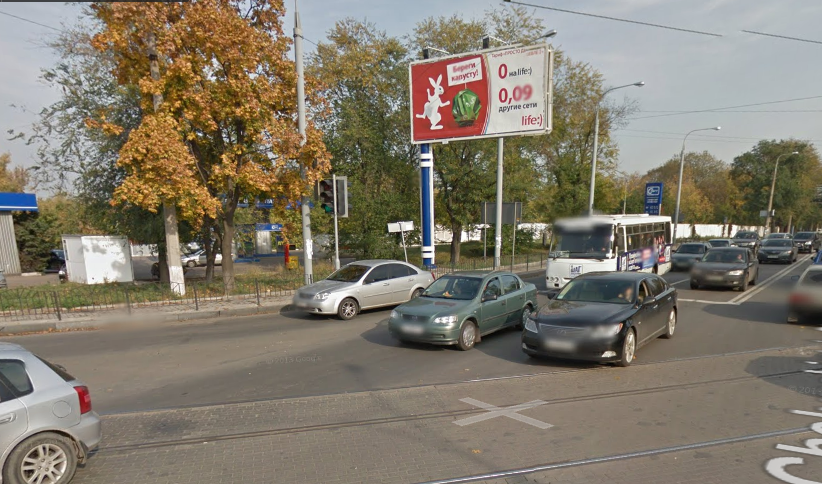
UPDATE:
Radio Svoboda, the Ukrainian Service of the US-funded Radio Liberty/Radio Free Europe, had a feature today uploaded to YouTube on the suffering of the people of Donetsk, who have been dodging shells and facing the loss of utilities and basic necessities. The video contained a number of interviews with elderly residents and mothers with small children who had decided to stay in Donetsk either because they had nowhere else to go or because they were reluctant to leave their homes and risk travel. They were going to the Donbass Arena to pick up humanitarian aid parcels arranged by the Pomozhem (“We’ll Help”) charity of oligarch Rinat Akhmetov.
While following the people in line at the arena, the cameraman twice caught sight of a Strela-10 nearby.
At 1:42, you can see a Strela-10 near a pink building and print shop which can be geolocated here at the corner of Chelyuskintsev and Mira Streets near the Donbass Arena and Olympic Stadium.
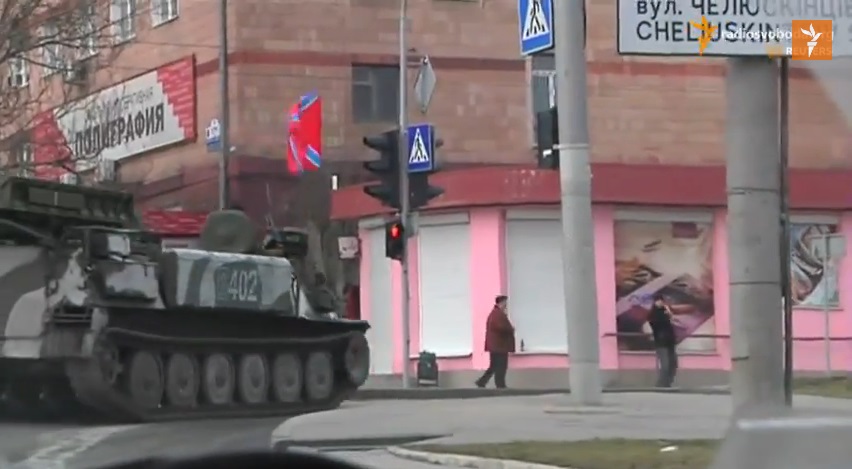
Here it is in Google Street View:
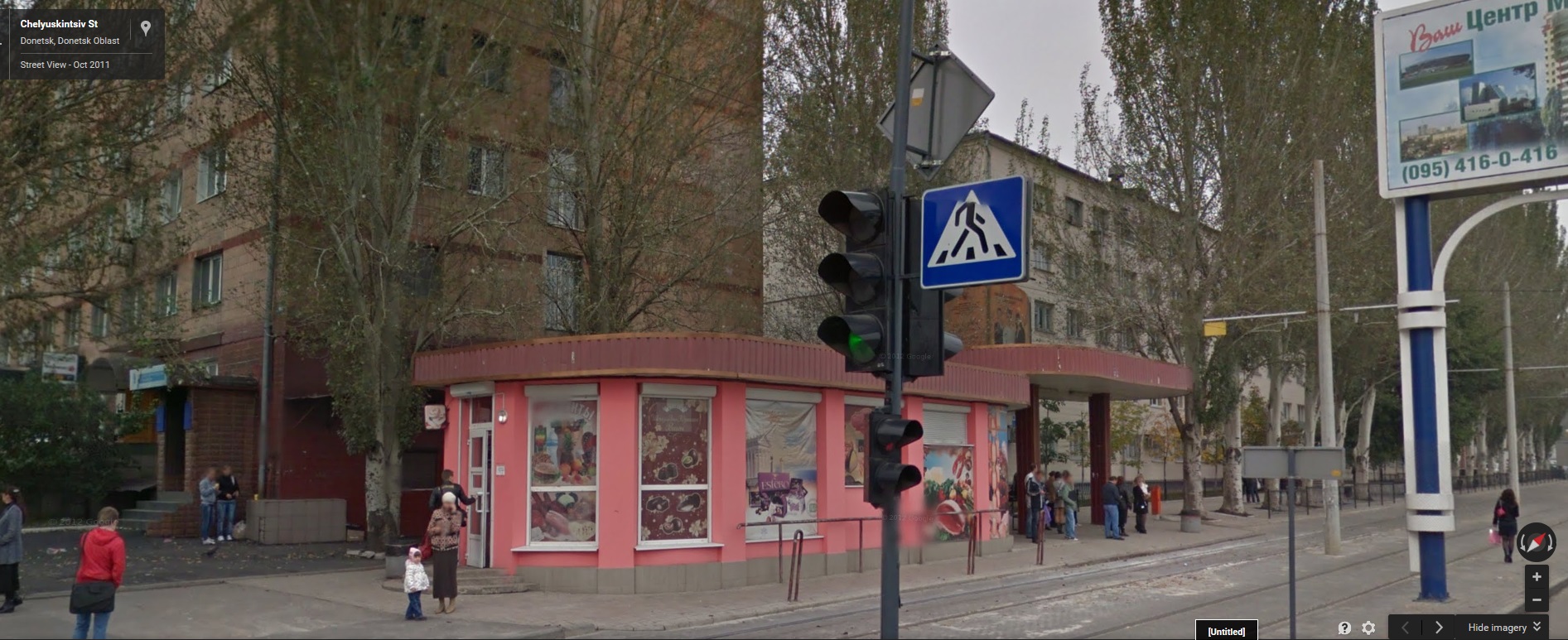
At 3:42, we can see a view of the Strela-10 similar to the Reuters photograph above. This can also be geolocated near the corner of Chelyuskintsev and Molodykh Shakhtyorov streets.
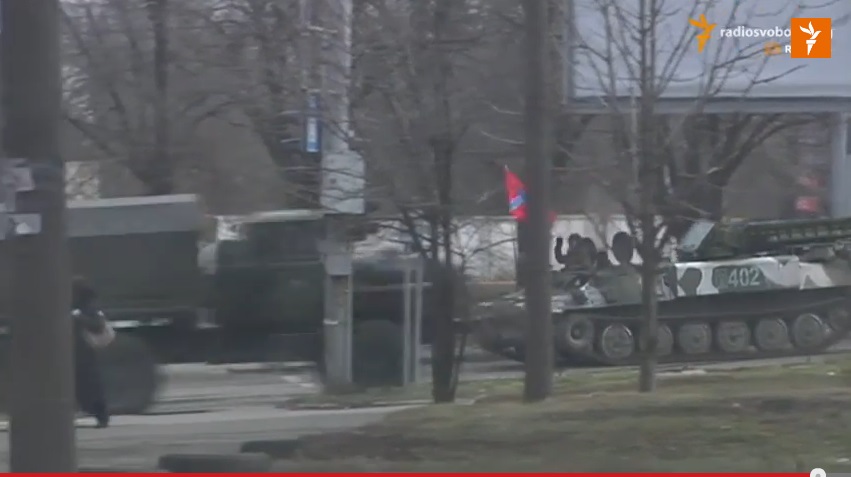
Here’s a map of the section of Donetsk where the two sightings were made of the Strela-10 to show their relative locations.
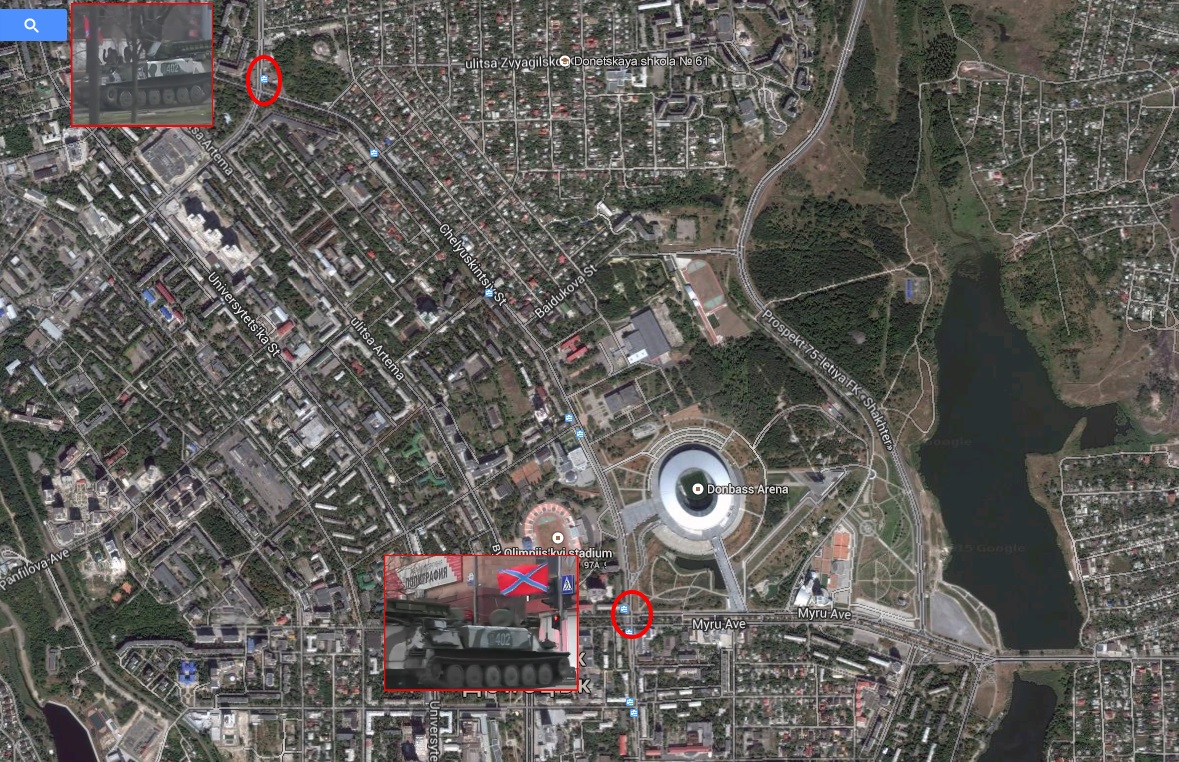
The regional Russian-language news site Obezrevatel’ reported other sightings of a Strela-10 on January 18, and local blogger Kozak Selid also found the one today.
— James Miller and Catherine A. Fitzpatrick
Russia’s Interfax news agency reports that Russian-backed separatist leaders are claiming to have shot down two Ukrainian military aircraft.
Igor Plotnitsky, the leader of the self-proclaimed ‘Lugansk People’s Republic,’ claimed that his separatist fighters shot down a Ukrainian attack jet today.
Plotnitsky said (translated by The Interpreter):
“Today, literally several minutes ago, a Ukrainian military aircraft was shot down. It crashed in the Irmino district. The pilot bailed out with a parachute. He is now being searched for.”
Claiming that more information would be received shortly, Plotnitsky said that preliminary reports suggested the aircraft was a Sukhoi Su-25 jet.
Meanwhile Interfax reports that Eduard Basurin, a military official in the ‘Donetsk People’s Republic,’ had claimed this morning that a Ukrainian military aircraft had been shot down by his fighters and had “burned up and crashed outside Debaltsevo.”

The Ukrainian Ministry of Defence has issued a statement, denying Plotnitsky’s claim regarding the downing of an Su-25 near Irmino.
The information spread by representatives of so called LNR distributed by information agencies and online media about Ukrainian AF aircraft allegedly shot down by terrorists over Irmino is FALSE.
The ATO press center asks journalists, bloggers, users of social networks to remain unprovoked by terrorists and spread information received from official sources only.
There has been no comment so far on Basurin’s claims.
We note that there has been no video or photographic evidence of these shoot-downs so far. Certainly, Irmino is within separatist-held territory so it would be surprising for the propaganda value of such a wreck, were it to exist, not to be exploited as quickly as possible.
It is interesting however, that these claims of downed Ukrainian aircraft come the day after we saw the first evidence of Ukrainian air assets in use since July last year, when flights over the conflict area of the Donbass were barred after Ukraine suffered heavy losses to Russian-supplied surface-to-air missile (SAM) systems.
Russian-backed fighters in Lugansk claim that they shot down an OTR-21 Tochka (SS-21 ‘Scarab’/9M79) ballistic missile on the night of February 1. This claim is interesting for two reasons: 1) it could serve as evidence that ballistic missiles are being used in this conflict and 2) it requires highly sophisticated weaponry to shoot down a ballistic missile.
IHS Jane’s throws cold water on the theory that the separatists actually shot down the missile. The weapon is missing the kind of holes in its body that we might expect to see if it were hit by a fragmentation missile from a Buk, S-300, or Pantsyr system.
One explanation, then, is that the missile suffered a mechanical failure and crashed. If this is the case, then the missile could have been launched by either side.
But Jane’s put out the theory that the missile may have dropped submunitions and then fell to the ground, since the remains of the weapon look similar to missiles found in Georgia after Russia’s 2008 invasion:
Photo evidence of the impact of Tochkas armed with unitary high explosive (HE) warheads from the Georgian conflict indicate that very little of the missile’s fuselage remains recognisable after detonation. However, during the Georgian war, the wreckage of several Tochka missile tail and body sections were found (often showing signs of having landed on their base), indicating that the missiles had broken up in mid-air.
One explanation given for this is that a fault in the missiles themselves has been causing some to become unstable in flight and to break up. This could be due to age, with the Tochka missiles mainly built in the 1980s – although some in service may date from as early as the late 1970s – or it could be from a manufacturing or design fault. That Russian forces are not known to have modernised or upgraded their Tochka inventories following the Georgian conflict indicates that the missiles were functioning as designed.
The most likely explanation is that both Russia in Georgia and Ukraine in this instance have been firing a submunition-armed version of the Tochka which, after dispensing its munitions, is becoming unstable and breaking up in the air.
While the article raises two possible answers — the missile failed and crashed, or it released submunitions and broke apart — Jane’s suggests that the weapon proves that Ukraine is using submunitions, endangering civilian lives.
The video, however, was not geolocated by Jane’s, which did not link to their source material in the article. The pictures they analyze were taken from a LifeNews broadcast, a Russian news outlet with extremely close ties to the Russian security apparatus and the separatists. A video (with English subtitles) shows that the missile has fallen in a desolate area
The video appears to have been taken near a slagheap, likely an abandoned mine, of which there are very many near Alchevsk. It’s clear from the conversation held by the fighters that this is near one of their bases or camps, and while Jane’s points out that “a circular error probable of up to 95-150 m and a 482 kg warhead the Tochka is by no means a precision-strike weapon,” most of these slagheaps are many kilometers away from any civilian areas.
In short, it’s not clear who fired this missile, but it’s certainly not clear this it was a threat to civilians in the area, and it’s worth noting that neither Ukraine nor Russia (nor the United States) are signatories of the Convention on Cluster Munitions.
In other words, while the Jane’s article does prove that the separatists almost certainly did not shoot down this missile, Jane’s takes several logical leaps when it blames Ukraine for endangering civilians, leaps which are not supported by the available facts.
— James Miller
A large convoy of Russian armored vehicles with what appear to be advanced radar systems has been spotted in Rostov Region of Russia near the Ukrainian border.
A video titled “RF Convoy Headed Toward Ukraine” was uploaded to YouTube yesterday, February 2.
We have geolocated the video to the area around the town of Krasny Kolos, here on Google Maps.
A sign for Krasny Kolos is visible on the highway at 1:25:
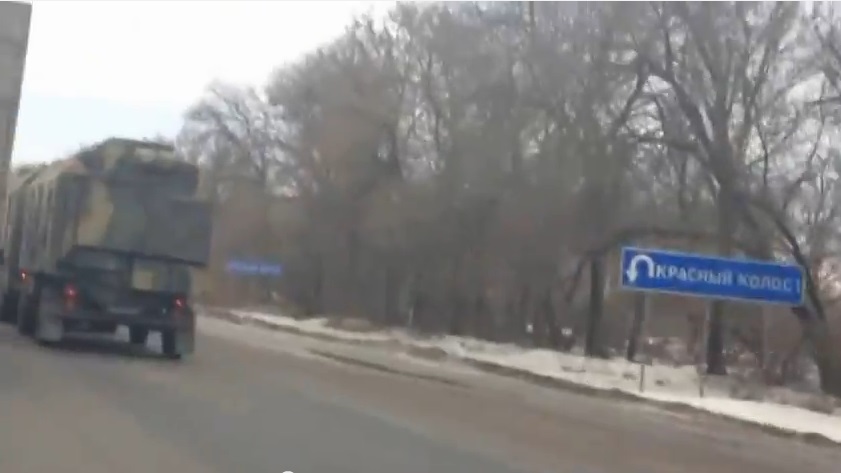
The car with the dashcam filming the convoy then passes a blue pedestrian bridge over the highway starting at 2:03 which is geolocated here on Google Maps:
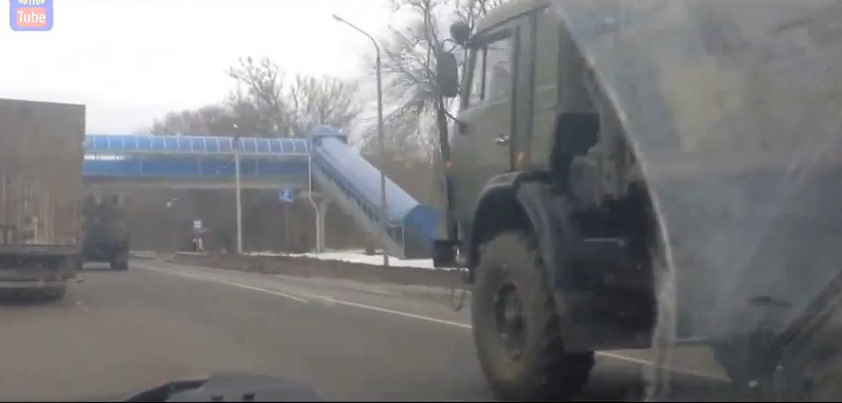
This can be seen on Google Street View here:
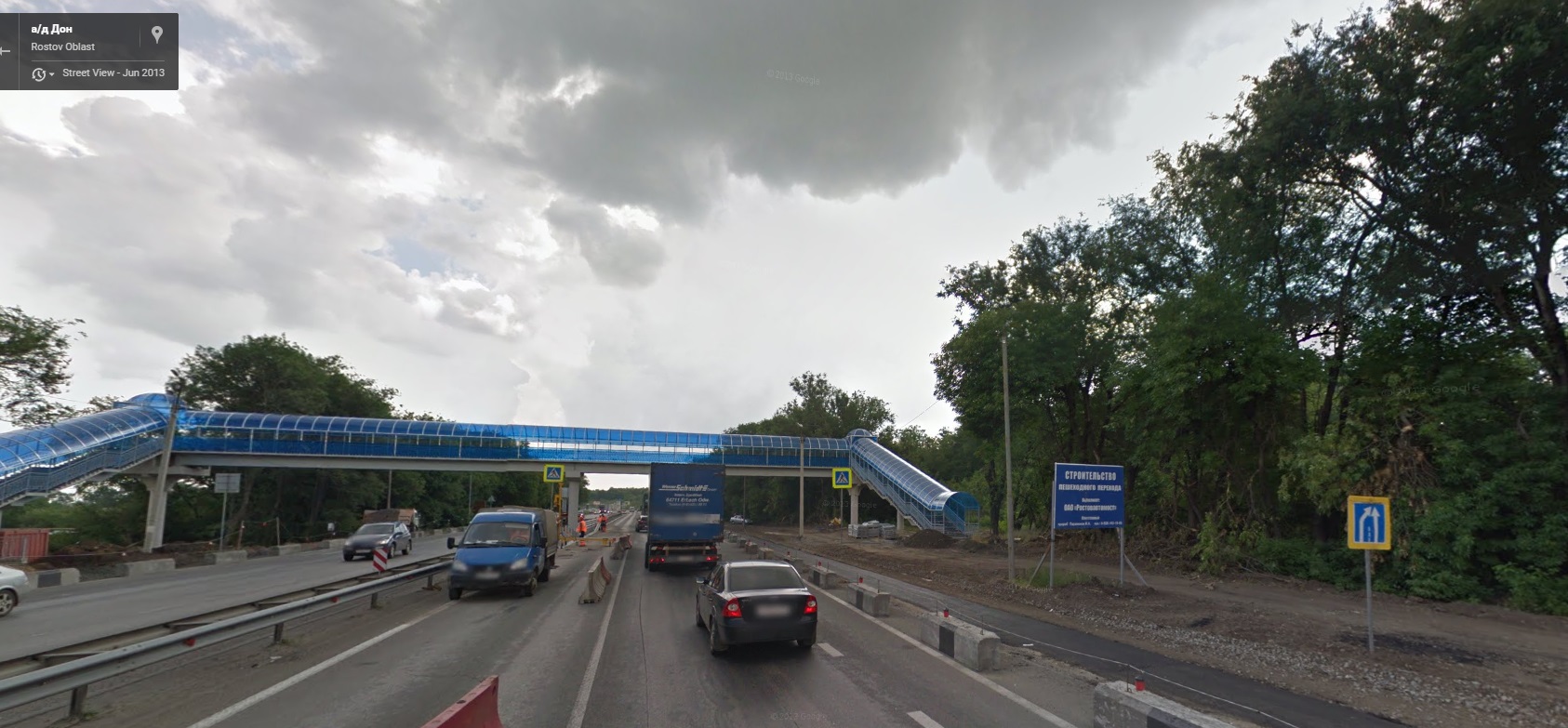
Then the sign for the fork to take the highway either to Novocherkassk or Moscow comes up at 3:28:
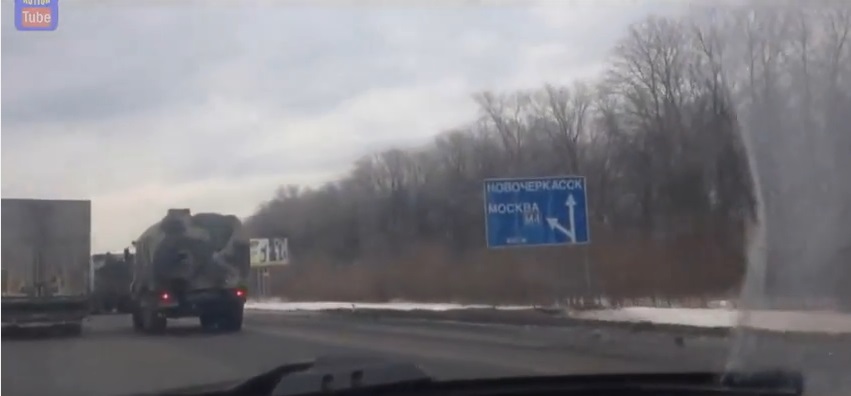
We then see the striped sign on a meridian at the fork at 3:59:
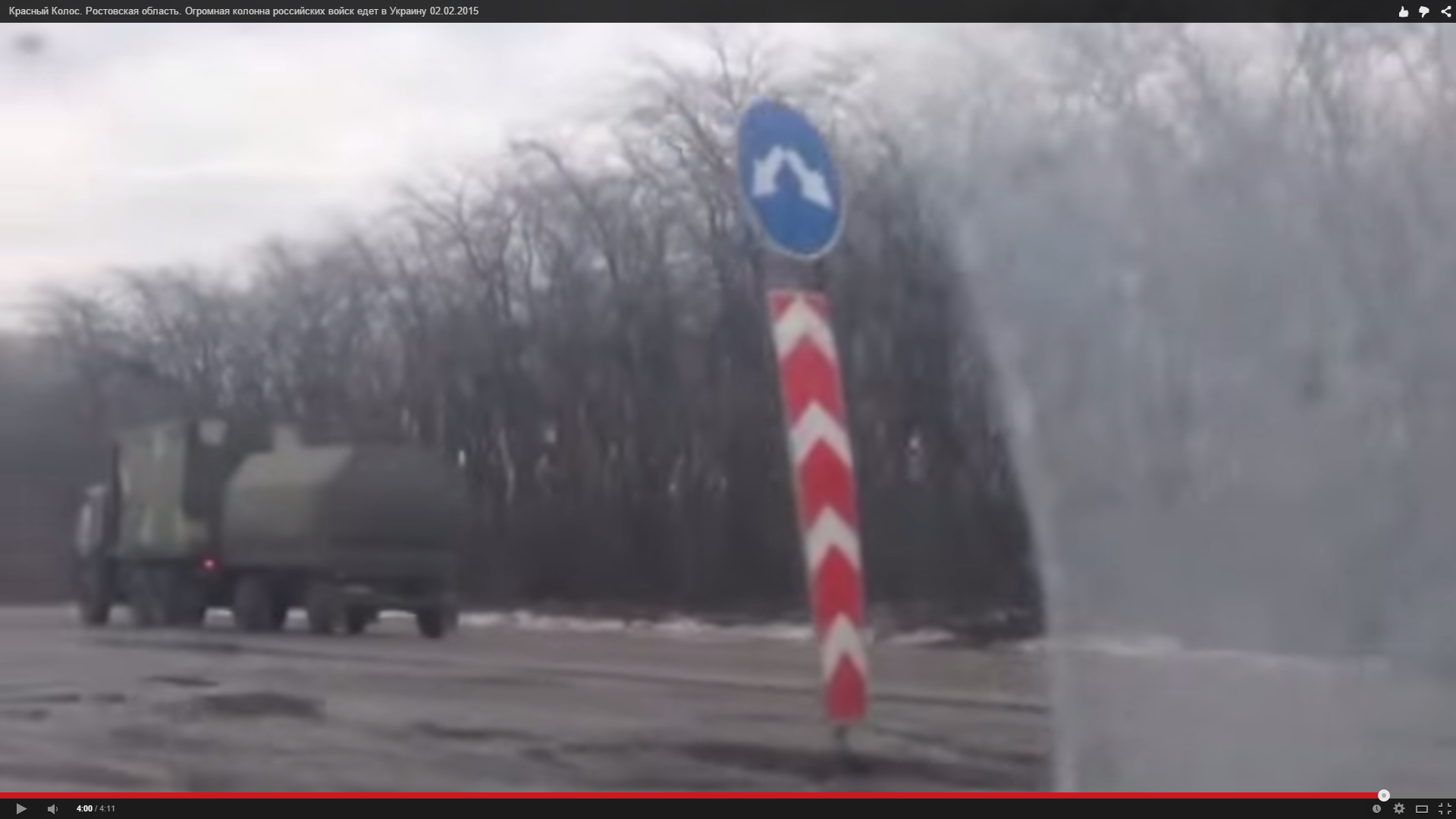
This particular fork is geolocated here on Google Maps, and we have a picture also from Google Street View:
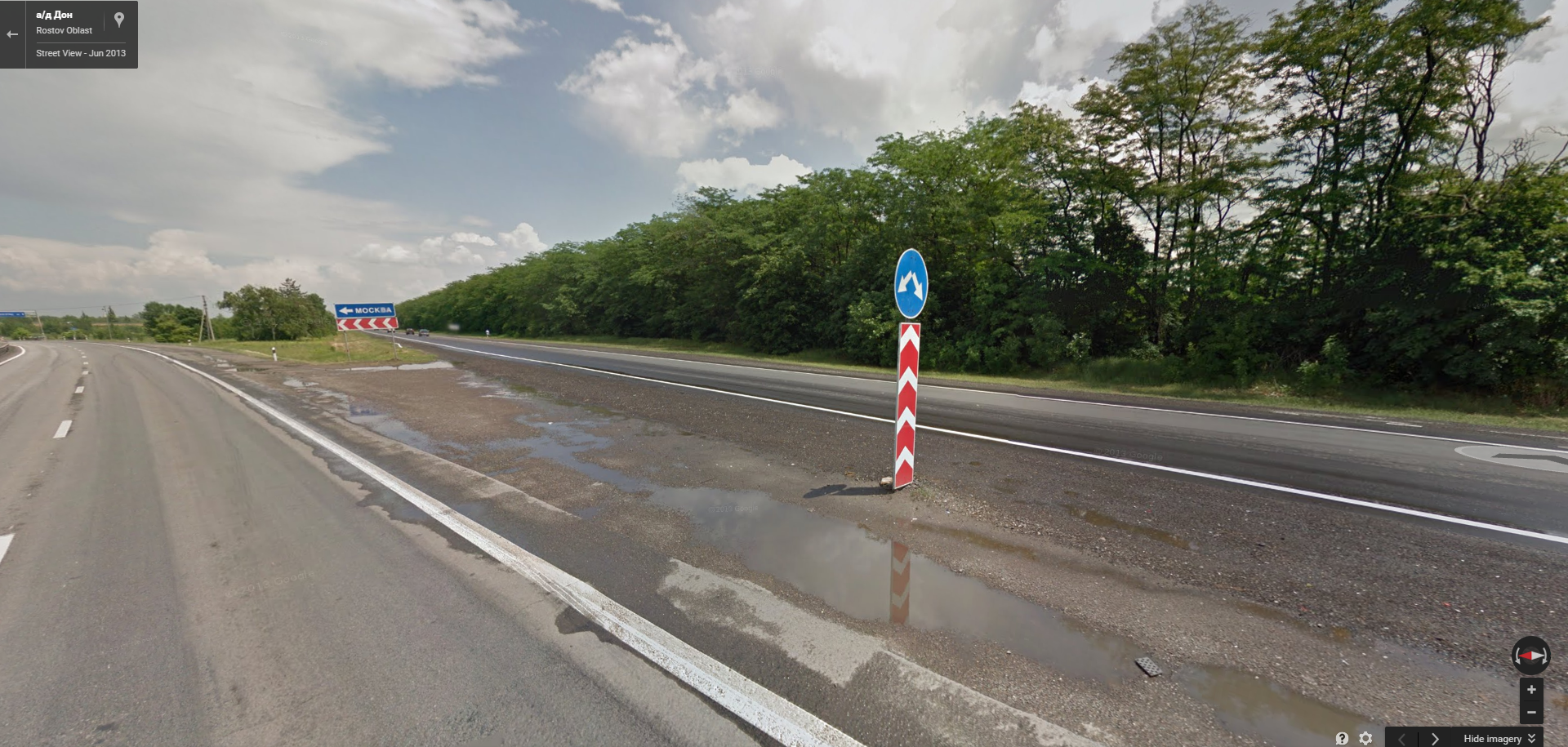
What this means is that the convoy is headed east in the direction of Novocherkassk, not the Ukrainian border. Or at least it has pulled off to the side of that road. Here’s a line drawn along the highway seen in the video:
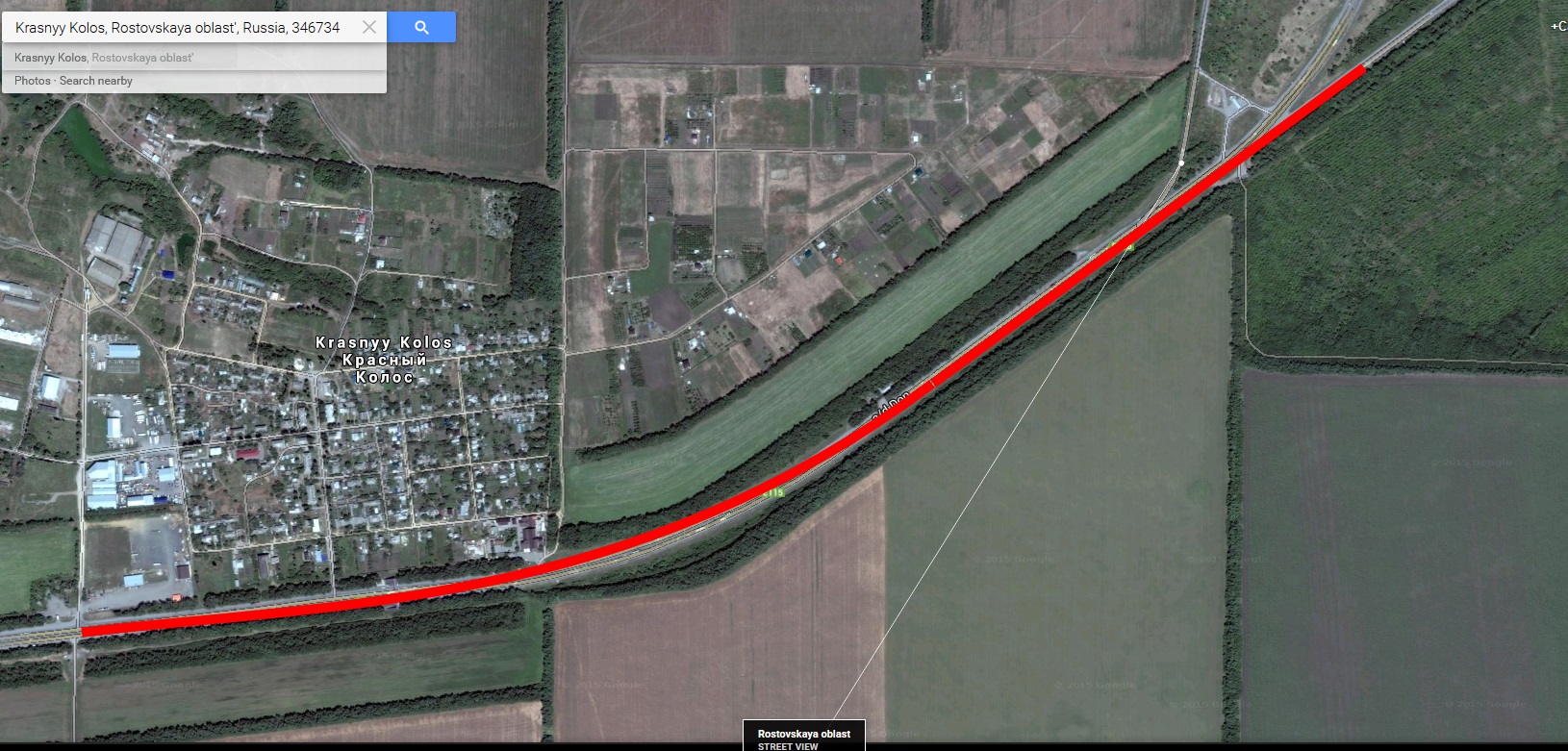
The argument often made both by Russians and those denying Russia’s military presence in Ukraine is that Russia has the right to move military vehicles around its own territory as it pleases, and that does not necessarily mean they are headed to Ukraine or will be involved in combat [this is not technically true since Russia has signed treaties with Ukraine which govern how it informs Ukraine about troop movement].
Yet when we repeatedly see large build-ups of armor, and see these large convoys near the border — and then have found so many of them winding up in Ukraine — there is indeed reason for concern, regardless of its direction at the particular moment it was spotted.
This particular convoy has a number of vehicles in it that appear to be related to electronic warfare as some bloggers have noted:
Some of the smaller trucks had camouflaged boxes on them:
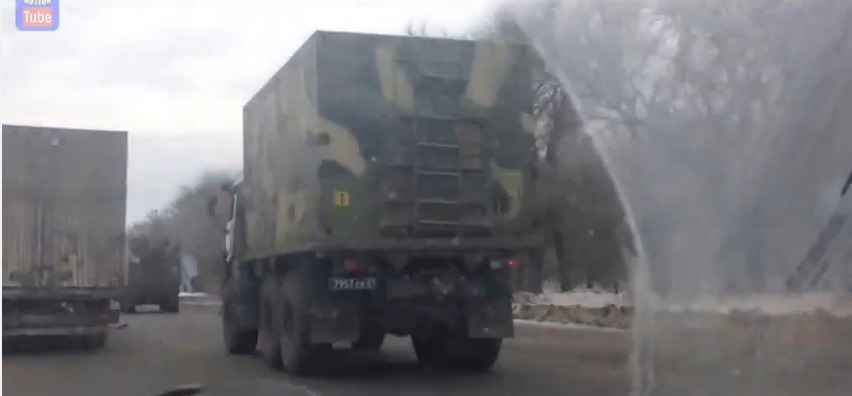
Russia introduced a new system in 2012 called Infauna “which is capable of jamming radio-controlled mines and improvised explosive devices,” says Defense.net.
At the 39 second mark, a different vehicle appears:
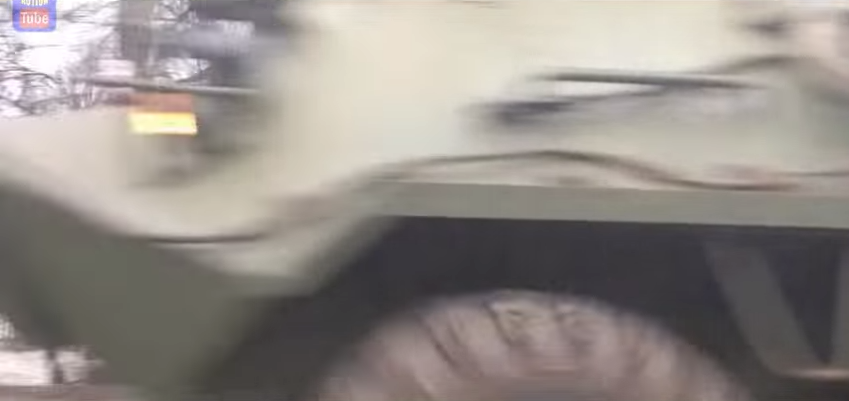
The MKTK-1A is a modular system consisting of several vehicles, matching closely the vehicles visible in this video:
We can’t make a confirmed identification of this system as the MKTK-1A and are still researching this convoy, but what we do know is that it is near Ukraine, and does have radar vehicles.
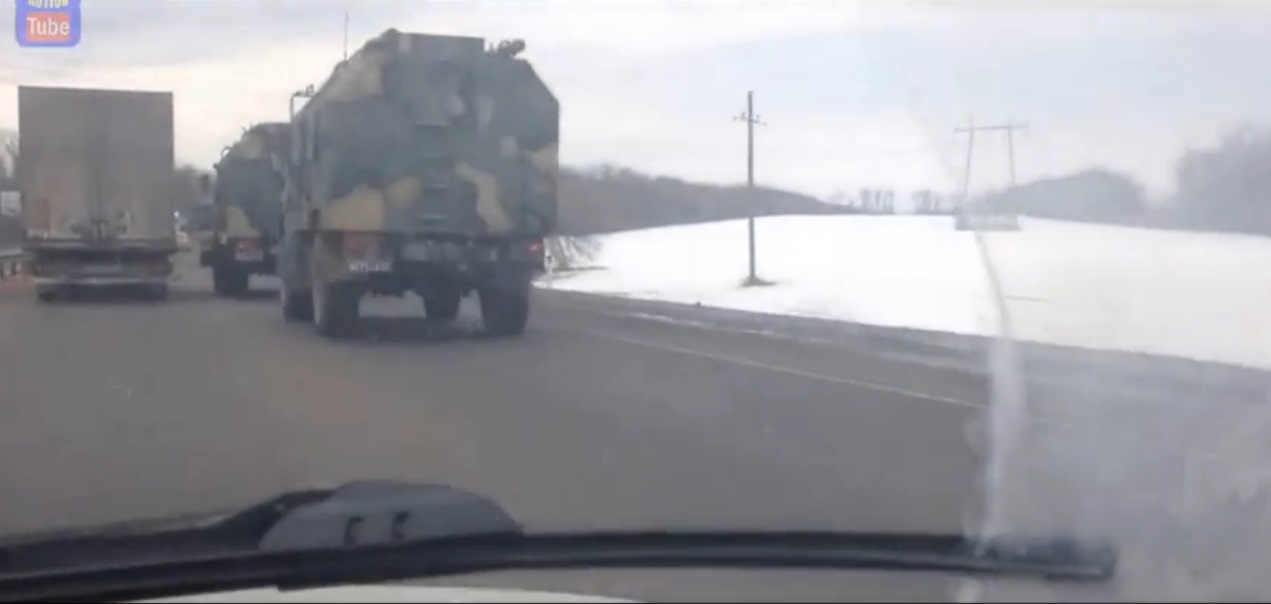
There are already claims that MKTK-1A vehicles have already been spotted inside Ukraine, though we have not confirmed those claims:
Ukraine’s TSN reports that, according to a fighter in his unit, Yevhen Tkachuk, a battery commander in the volunteer-based 25th Kiev Rus motorised infantry battalion, has been arrested for treason after giving an order to retreat from positions near Debaltsevo.
The source, named as Oleg, who was amongst those who withdrew with Tkachuk, told TSN that he had been informed by a military prosecutor that his commander was now in the garrison headquarters in Kharkiv.
Oleg said that Tkachuk had been charged on two counts: failure to comply with a military order (although Oleg says that no such order existed) and “betrayal of the Motherland.”
Yesterday, Oleg told TSN that Tkachuk’s decision to withdraw from Uglegorsk (Vuhlehirsk in Ukrainian), which was being over-run by Russian-backed forces on January 30, was made out of necessity.
Oleg said that his unit had held out as long as possible under regular Grad rocket fire while Ukrainian forces were driven back from Uglegorsk. Having withdrawn to a position near the village of Savelovka, around 4 km from Uglegorsk, they established anti-tank batteries.
However, Oleg said, the troops were approached by local residents who carried word from Russian-backed fighters. The message was that if the Ukrainian forces remained in the area by the morning, the Russian-backed militants would “completely level the ground” and “massacre the survivors.”
Tkachuk attempted to contact the ATO headquarters and also sent word through volunteer activists, but no response was received. Faced with the threat to his soldiers’ and the villagers’ lives, Tkachuk gave the order to withdraw to a safe location.
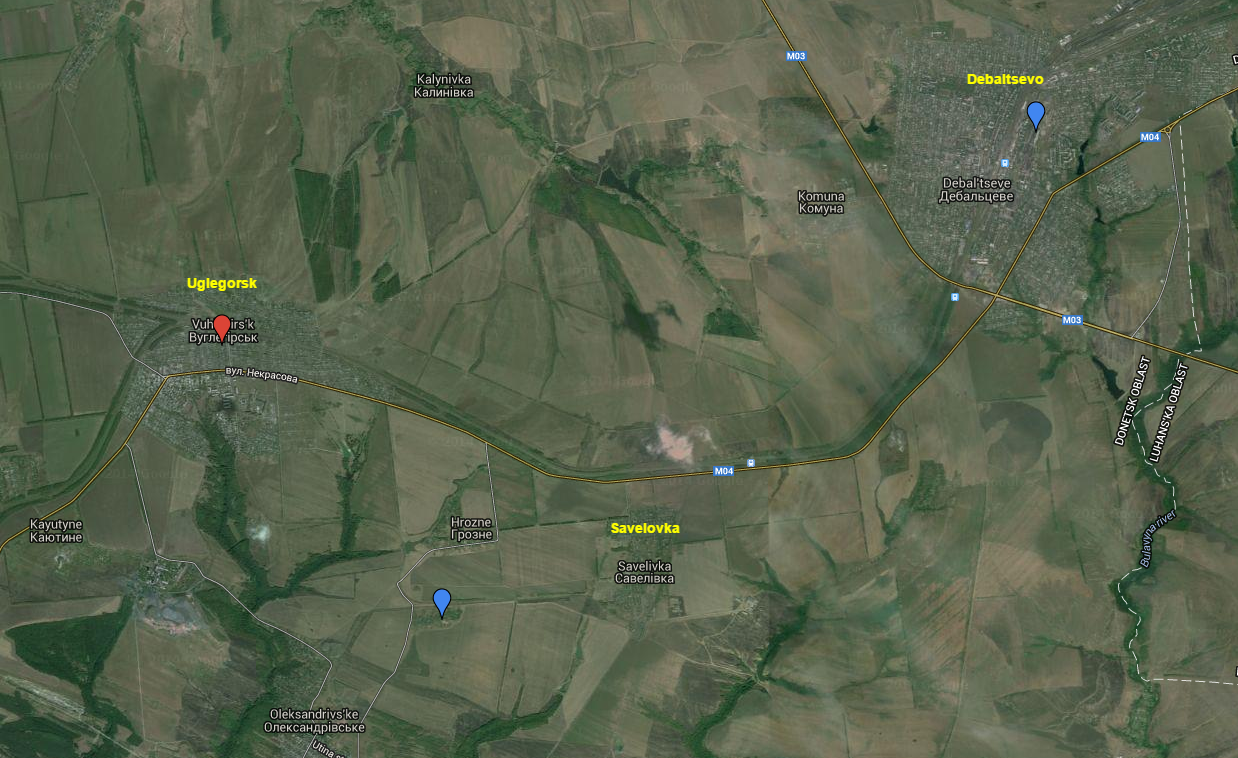
— Pierre Vaux
Reports from Debaltsevo, a strategically vital town held by Ukrainian forces that Russian-backed fighters are attempting to encircle, describe intense shelling today:
Shelling was also reported last night in Popasnaya, a Ukrainian-held settlement on the front line to the north-east of Debaltsevo:
Translation: Popasnaya, bakery. The Russian World [a concept of pan-Russianism espoused by Vladimir Putin and nationalists] has “arrived.” February 2.
Amidst the devastation wrought by constant shelling, and fears that Russian-backed forces may break through and assault Debaltsevo itself, the Ukrainian authorities have been attempting to organise an evacuation of civilians.
Novosti Donbassa reported this morning that the press office of the Emergencies Ministry had announced that 66 civilians, including 3 children, had been evacuated from the town over the previous day. This was part of a wider evacuation effort from front-line towns suffering bombardments, including Avdeyevka (north of Donetsk) and Svetlodarsk (north-west of Debaltsevo). In total, the Ministry claimed, 156 civilians, including 44 children had been evacuated.
There were however reports that despite the shelling, the threat of attack and the collapse of all essential infrastructure, there was some resistance to evacuation attempts:
Meanwhile the Kievpastrans bus company announced this afternoon that a convoy of their buses, which were carrying refugees, came under fire outside Debaltsevo.
Kiev news site 44.ua reported that, according to Kievpastrans, two drivers were wounded and one of their three vehicles had to be left on the scene.
— Pierre Vaux
In an apparent attempt to play down yesterday’s reports, from The New York Times and the Associated Press, that the United States was now considering supplying the Ukrainian government with “lethal defensive weapons,” Ben Rhodes, White House deputy national security adviser, has told Deutsche Welle that sanctions, rather than military aid, remained Washington’s tool of choice.
In an interview with CNN, White House deputy national security adviser Ben Rhodes said that sanctions were the best way of applying pressure on Russia. “We don’t think the answer to the crisis in Ukraine is simply to inject more weapons and engage in tit-for-tat,” he said.
US State Department spokeswoman Jen Psaki also emphasized that the US was not immediately looking for a military solution: “I don’t think anybody wants to get into a proxy war with Russia,” she said, saying that the objective was “to change the behavior of Russia. That’s the reason we have put the sanctions in place.”
Deutsche Welle notes that Chancellor Angela Merkel has made her opposition to supplying Ukraine with arms public, and that she is due to be received at the White House next week for what Rhodes described as a “very important” meeting, at which the Ukrainian issue will be a key topic.
— Pierre Vaux